Karzai & Associates Budget:
Print Money [quietly] and Hope for Foreign Largesse
"International donors have been assessing finance ministry procedures for handling the massive infusions of foreign aid, which the western-backed government needs to stay in power. But, perceptions of corruption have been a big obstacle, according to diplomats."1
by Marc W. Herold
Departments of Economics and Women's Studies
Whittemore School of Business & Economics
University of New Hampshire
POSTED MAY 29, 2002 --
The Karzai & Associates' government budget for 2002 was unveiled in early April at a two-day donor's conference in Kabul.2 Planned expenditures are $460 million and planned receipts as of this writing, are $260 million [including $83 million to be generated from taxes]. About $200 million is destined to pay for salaries of the military, the police [25,000 strong], and government employees [210,000 strong].
In late December 2001, various 'supporting nations' pledged $20 million to the newly installed Karzai regime. About $6 million of these UNDP monies was flown into Kabul airport in late January under the cover of darkness in a United Nations' aircraft.3 The funds were to allegedly pay civil servants [on January 22] who had not been paid for six months. An Italian police contingent of the ISAF took consignment of the stash in an armored vehicle for safe storage. The United Nations also paid the Russian Government $1 million for 300 billion newly minted Afghanis [about $6 million]. Another $12 million of UNDP monies are being used to pay government employees through this June.
Karzai's numerous intercontinental junkets came out long in pledges, but short on cash for current government expenditures. Foreign donors, quite understandably, expressed reservations about financial transparency, preferring to commit goods in kind or direct project aid. In a state visit early April, Pakistan's president handed Karzai a check for $10 million.4 China had given a quick $1 million in January during Karzai's state visit to Beijing.5
The bulk of currently funded expenditures comes from the World Bank, the United Nations Development Program and related agencies, and the Asian Development Bank - funds totaling about $ 160 millions [see Table below]. In March, the Asian Development Bank provided Kabul with a $15 million technical assistance grant for 'government capacity building.' In early April, the World Bank granted Kabul $100 million in direct budget support.6 Total planned receipts amount to $256 million, leaving an operational budget shortfall of over $200 million.7 By May, Afghan Finance Minister Heydayat Amin-Arsala was begging international donors to provide funds to pay doctors' and teachers' wages while in the same breath, predictably, asserting that in a modern Afghanistan economic growth would be driven by private enterprise.8
The Karzai regime has said it can come up with internal funds amounting to $83 million through taxes .9 But most of these tax receipts and license fees depend upon regions furnishing resources to the Kabul government, a very dubious proposition. A much more likely source of internal funds will come simply from printing money, a procedure used by the previous Uzbek General Rashid Dostum and the Northern Alliance Rabbani government.10 The director of the Middle Eastern Department at the International Monetary Fund, Paul Chabrier, in January discovered in a visit to the customs office in Kabul that it had raised $12 million in the latter half of 2001 through duties on imports. The problem in his words was that "we don't know where the money went."11 The central government has barely collected any revenue locally with government expenditures being handled by 'deficit finance - by printing banknotes.' A Finance Ministry official reported in late February that a number of regions in Afghanistan were also printing their own banknotes, with the official adding "there is one company in Russia printing banknotes of different shapes and sizes for everyone."12
Table 1. Karzai's Central Government Budget for 2002
| Planned expenditures |
$460 million |
| Planned receipts |
$256 million |
|
- Kabul government taxes |
$83 million |
|
- UNDP and related |
$47 million |
|
- China |
$1 million |
|
- Pakistan |
$10 million |
|
- Asian Development Bank |
$15 million |
|
. World Bank |
$100 million |
| Budget deficit |
$200 million |
-- 30 --
Footnotes
1. Charles Clover, "Kabul Insists Aid Distribution is Working," The Financial Times [February 25, 2002].
2. The phrase 'Karzai & Associates' is elaborated upon in my "The 'Karzai and Helpers Vision' of Afghanistan's Reconstruction: the Kabul Intercontinental Hotel as [its] Metaphor" [Durham, N.H.: unpublished manuscript, Departments of Economics and Women's Studies, University of New Hampshire, May 2002]. The prostrate condition of Afghanistan's financial infrastructure is described in Charles Recknagel, "Afghanistan: Reconstruction Will Require Resuscitating Banking Sector," Eurasia Insight [December 26, 2001], at : http://www.eurasianet.org/departments/business/articles/pp122601.shtml . See also "Currency Problems Cloud Afghanistan's Economic Prospects," The Taipei Times [December 24, 2001], at : http://www.taipeitimes.com/news/2001/12/24/print/0000117185
3. Guy Dinmore, "Kabul Desperate to Receive Cash Lifeline," The Financial Times [February 5, 2002]: 12.
4. Pamela Constable, "Musharraf Offers Hand, Aid Check During 1-Day Visit to Afghanistan," Washington Post [April 3, 2002].
5. "China Renews Pledge of Aid During Karzai Visit," China Daily [January 24, 2002].
6. "World Bank Offers Up to US $ 100 Million Budget Support to Afghanistan," Relief Web [April 2002].
7. Rachel Morajee, "Afghan Finance Minister Makes Plea for Funds to Pay Wages," Relief Web [May 9, 2002].
8. Morajee, op. cit.
9. The Financial Times [April 11, 2002] and [April 15, 2002].
10. Recknagel, op. cit.
11. Mark Landler, "I.M.F. Backs Official Shift to U.S Dollar by Afghans," New York Times [January 31, 2002].
12.Clover, op. cit.
Cursor
homepage
Back to Karzai & Associates' Trickle-Down Reconstruction
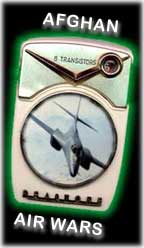
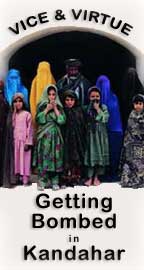
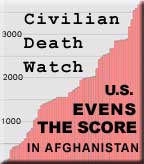
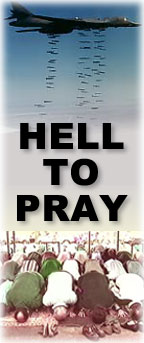

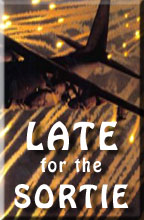

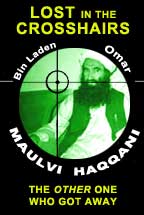
- CURSOR EXCLUSIVE -
January 6, 2002
Recent 'Success' Tally of U.S. Bombs:
Over 200 Civilians are Killed to Get 1.5 Taliban Leaders
- CURSOR EXCLUSIVE -
January 6, 2002
Afghanistan War Produces High Civilians-Killed-Per- Bomb-Dropped Ratio
Appendix 5
Spatial Distribution of Afghan Civilian Casualties Caused by the U.S. Air War, October 7 - December 6th.
Appendix 4
Daily Casualty Count of Afghan Civilians Killed in U.S. Bombing Attacks
A CURSOR EXCLUSIVE

December 29, 2001
The Guardian
December 20, 2001
The Innocent Dead in a Coward's War
Estimates suggest US bombs have killed at least 3,767 civilians
Houston Chronicle
December 20, 2001
We Can't Just Forget
About Dead Afghan Civilians
San Francisco Bay Guardian
December 20, 2001
Life During Wartime
Destroying Afghanistan to save it
WorkingForChange
December 18, 2001
The Forgotten Dead
Do you know how many
have died? Didnšt think so.
Counterpunch
December 17, 2001
Civilian Casualties:
Theirs and Ours
New York Times
December 15, 2001
An Unlucky Place
An Afghan village where
errant bombs fell and killed,
and still lurk in wait
Monkeyfist.com
December 13, 2001
Bombing & Starvation
Civilian casualties in Afghanistan
TomPaine.com
December 13, 2001
What's Not In The News
Why we aren't hearing the
whole story from Afghanistan
Common Dreams
December 13, 2001
Ari & I
White House press
briefing with Ari Fleischer:
Second question, a
professor at the University
of New Hampshire reported...
FAIR
December 12, 2001
How Many Dead?
U.S. TV networks
aren't counting
Newsday
December 11, 2001
U.S. Wages Overkill in Afghanistan
Common Dreams
December 10, 2001
More Than 3,500 Civilians
Killed by U.S. Bombs
University of New Hampshire
Economics professor releases
study of civilian casualties
in Afghanistan
TomPaine.com
December 7. 2001
Denying the Dead
In Pentagon reports
of Afghan dead, truth
is the first casualty
FAIR
November 8, 2001
Civilian Casualties Not News on FOX News
Slate
November 2, 2001
Moral Equivalence
How many Afghan civilians is the life of one American soldier worth?
Scoop
(New Zealand)
October 26, 2001
Bush's War Threatens Millions With Starvation
Norm Dixon
Coming in January from
Freedom Voices Press
& City Lights Publishers:
"September 11
and the U.S. War:
Beyond the
Curtain of Smoke"
Contributors include:
Wendell Berry
Jeff Cohen
Robert Fisk
Eduardo Galeano
Marc Herold
Michael Klare
RAWA
Ted Rall
Norman Solomon
Cursor
homepage








